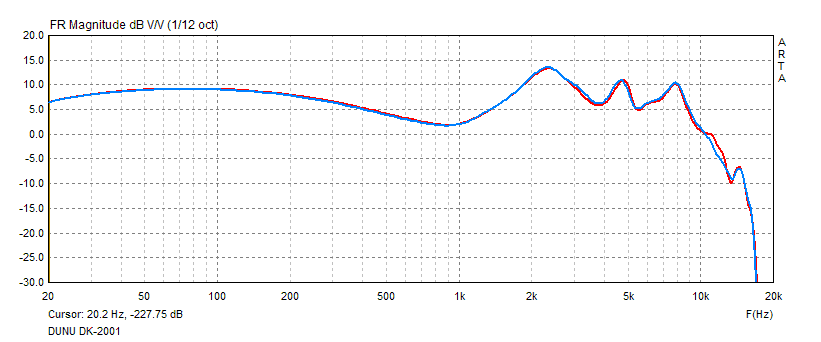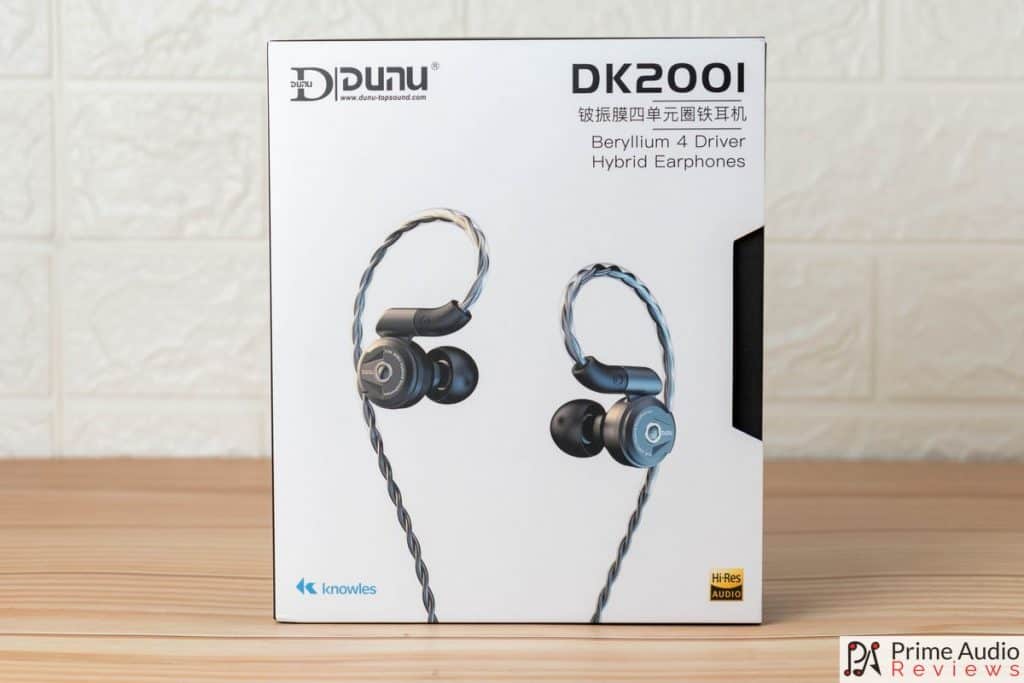I’ve been a DUNU fan since I first heard the DN-2000 and then later reviewed the DK-3001. What made them stand out to me was not just the excellent sound but also the quality of craftsmanship of their IEMs. So naturally, I was quite excited to learn about the DUNU DK-2001, which is the subject of this review.
The DUNU DK-2001 is a quad-driver IEM consisting of three Knowles balanced armature drivers and a single dynamic driver. It also comes with DUNU’s modular cable tech, which we’ll look at in more detail later on.
DUNU official website: https://www.dunu-topsound.com/
This sample was provided for the purpose of an honest review. All observations and opinions here are my own based on my experience with the product.
DUNU DK-2001 Review
- Class-leading build quality
- Comfortable and durable
- Modular cable system
- Expansive soundstage and strong imaging
- Timbral accuracy
- N/A
Package and Accessories
The DK-2001 unboxing experience begins with a cardboard outer sleeve which has a clear image of the earphones on the front and a list of specifications on the back. The box proper is matte black with some glossy branding on the outside.
Within the box, the IEMs are seated in a foam insert and all the accessories are found underneath the foam. Below is a breakdown of the box contents.
- High-Purity Silver-Plated OCC Copper Litz (Type 1) Cable
- Modular 3.5 mm Single-Ended Plug
- Cerulean Blue Leatherette Zip-Up Carry Case
- DUNU DC-16 3.5-to-6.3 mm Adapter
- Cleaning Brush & Loop
- ‘Balanced’ Silicone Ear Tips (4 Pairs)
- ‘Transparency’ Silicone Ear Tips (3 Pairs)
- ‘Vocal’ Silicone Ear Tips (3 Pairs)
- Memory Foam Tips (1 Pair)
Build Quality and Design
Build quality is something that DUNU does better than most and it’s apparent again here with the DK-2001. Constructed from 316 stainless steel, just like the DK-3001, you can rest assured that you won’t have any durability issues with the housings. The DUNU DK-2001 is available in three colours: topaz, turquoise and obsidian.
The DK-2001 maintains a similar shape and design as the other IEMs in the DK series with a circular shell and angled nozzle. The nozzles have been improved since the DK-3001 and now have a solid ridge that prevents eartips from sliding off. There’s a single small vent between the base of the nozzle and the top part of the shell.

Attached to the top of the shell is a horizontal tube containing DUNU’s unique Catch-Hold® MMCX connector which is claimed to “reduce spin and improve service life. Only time will tell if the service life is improved but the MMCX connection feels very firm and does not spin easily.
On the faceplates is a small dome-shaped vented grill, giving the DK-2001 a semi-open design. These vents are real too and not purely aesthetic, as the sound is noticeably altered when they are covered up.
Comfort and Noise Isolation

Comfort was the one area I was concerned with since it was an issue with the DK-3001 and these shells have a very similar shape. But thankfully, DUNU listened to user feedback and additionally drew on information from a huge ear database to minimize chafing hotspots and make the edges smoother on their later models, including this one.
Thus, the DK-2001 is mercifully comfortable and I’ve had multiple extended listening sessions with them and haven’t experienced any discomfort whatsoever. Although the stainless steel shells have a little heft to them, I would still consider these to be a lightweight earphone.
Noise isolation is slightly less than average because of the semi-open nature of the earphones but it’s still good enough for use in public and noisy areas. I’ve used these in a busy shopping mall and couldn’t hear anything but my music and I generally keep the volume down fairly low.
Cable
For the cable, DUNU has included a high-purity silver-plated Ohno continuous cast (OCC) copper Litz Type 1 wire. This 4-strand twisted cable is simply gorgeous with its black and dark grey exterior.
Handling is exquisite: the cable is silky-smooth to the touch and it’s very supple, so it drapes really nicely too. In addition, it is extremely quiet in terms of microphonics and it is resistant to tangling.
This cable comes with DUNU’s excellent Quick-Switch™ modular plug cable system which allows you to quickly and easily switch out the termination. It comes with a 3.5mm single-ended termination as standard and additional 2.5mm, 3.5mm and 4.4mm balanced plugs can be bought separately.
The termination plugs are right-angled and are super easy to switch out. The Y-split is a simple, lightweight aluminium cylinder and there’s a transparent plastic cable cinch with matching diameter. At the top of the cable are the curved MMCX housings and some flexible heat-shrink ear guides.
Sound
Gear used for testing includes the Shanling M5s, Soundaware M2Pro and Sony NW-ZX300. Prior to any critical listening, the DK-2001 had more than 50 hours of burn-in.
DUNU’s DK-2001 is an efficient IEM and actually sounds pretty good straight from my Android smartphone. However, I did notice an improvement when using a good DAC or DAP, both of which sounded smoother but still every bit as resolving.
The overall presentation is fairly linear across the board with a slight bump in the upper midrange. It’s a very clean but smooth sound with excellent clarity and dynamic range. I found the timbre to be very natural and accurate from top to bottom. At the same time, the DK-2001 has very good detail retrieval and the sound from the hybrid quad-driver mix is coherent and organic.

Bass
The bass crafted by the 13mm beryllium-coated dynamic driver is very nicely weighted. There is a hint more mid-bass than sub-bass but the transition is fairly linear. Sub-bass has a sonorous extension with a smooth, deep rumble. Both the sub-bass and mid-bass are very textured with just the right amount of attack and decay to sound very natural and organic.
In Hans Zimmer’s “Imagine The Fire” the drums feel powerful and have a strong resonance that doesn’t intrude on the midrange. The bass has a natural decay that doesn’t feel either exaggerated or restrained, as if it has the authority of a dynamic driver but the strict control of a planar driver.
Mids
DK-2001’s midrange is again very natural and expertly handled. Instruments and vocals have just the right amount of body and density. They’re warm enough to sound accurate, yet the note size is trim enough to maintain exemplary separation and clarity.
I can’t stress enough just how well the DK-2001 portrays an accurate timbre. Vocals and instruments alike sound very natural; they have enough warmth to sound lifelike yet the air in between each element remains clear and free of any stifling thickness.

Treble
The treble of the DK-2001 is smooth and non-fatiguing, however, it is still crisp with ample detail retrieval and good extension. This is one of those trebles that is a juxtaposition in itself: The extension is there, the detail is there but it’s delicious and creamy in its delivery and never gets anywhere near harsh or overly bright.
Soundstage
The DK-2001’s soundstage is both wide and deep. It’s larger in size than average yet vocals and instruments have good density and the imaging is accurate. Layering is also very precise and it creates a holographic 3D image that immerses you in the music. Simply put, the DK-2001 is at the top of its class when it comes to soundstage and positioning.
Comparisons
Fearless Audio S6RUI ($389)

The S6RUI (review here) is more upfront across the spectrum – it’s very direct compared to the DK-2001’s more ambient style. It’s warmer with a thicker midrange and a more pronounced lower treble. Due to the extra bass and thicker midrange, the S6RUI’s soundstage feels smaller and more confined, although it does retain similar strong instrument separation and resolution.
The S6RUI has a starker and denser treble, helping preserve precise imaging but in a less expansive space than the DUNU creates. Its vocals are more intimate and immediate than the more open DK-2001.
Shanling ME500 Platinum Edition ($299)

The Shanling ME500 PE (review here) has a slightly smaller soundstage but one that is also quite precise in terms of imaging and positioning. It has more pronounced sub-bass and punchier mid-bass but then follows a similar frequency curve (and sound) up until the lower treble where it gains a small boost in the 3.5-5kHz region.
Despite its slower treble roll-off in the uppermost registers, the DK-2001 still manages to sound more airy and expansive: probably thanks to its semi-open design. ME500 PE has a crisper treble with a touch more sparkle and bite.
DUNU DK-3001 ($469)

The DUNU DK-3001 (review here) also has a quad-driver configuration consisting of a single 13mm dynamic driver and 3 Knowles balanced armature drivers. Its sub-bass is just a touch more elevated and the transition into the mid-bass is a little more linear.
Looking at the graph, it’s clear that the DK-2001 is a direct descendant of its older sibling. What’s important to keep in mind though, is that the DK-2001 has a semi-open design and that changes the fundamentals of the sound significantly.
The DK-3001 is has a stronger contrast in its dynamic range with denser notes and a more visceral, direct sound, while the DK-2001 is a whisper more diffuse and even in its presentation. DK-3001’s end to end extension is slightly better too and its imaging is more precise.
In terms of absolute sound, the DK-3001 still has a small advantage over the DK-2001. But if you take into account the lack of any ridge on the DK-3001’s nozzles (I just now had to fish an eartip from my ear), the inferior fit/ergonomics and the non-modular cable, I think the DK-2001 offers the best value here. If you already have a DK-3001, I don’t see any reason to acquire the DK-2001 unless you have comfort issues with the latter.

Conclusion
So there you have it. The DUNU DK-2001 is a true baller of an earphone. It has the stellar build quality we’ve come to expect from DUNU, plus one of the best stock cables I’ve ever seen bundled with a mid-tier IEM. In addition, it has an enchanting, clear, engaging and coherent sound with a class-leading soundstage. Need I say more? The DK-2001 gets my highest recommendation and an esteemed spot on our Best Universal IEMs list. If you’re shopping for a mid-tier IEM, you owe it to yourself to check this one out.
Specifications
- NET WEIGHT: 14 g
- FREQUENCY RESPONSE: 5 Hz – 40 kHz
- IMPEDANCE: 13 Ω
- SENSITIVITY: 109 ± 2 dB at 1 kHz
- TOTAL HARMONIC DISTORTION:< 0.5% at 1 kHz
- WIRE MATERIAL: High-purity silver-plated Ohno continuous cast (OCC) copper Litz Type 1 wire
- CABLE LENGTH: 1.2 mm
- CABLE CONNECTOR: Catch-Hold® MMCX
- DYNAMIC DRIVER: 13 mm dynamic driver with dual-sided Beryllium diaphragm coating
- BALANCED ARMATURE(S): 3 custom-ordered Knowles BA Drivers (1 mid-high, 2 ultra-high)










